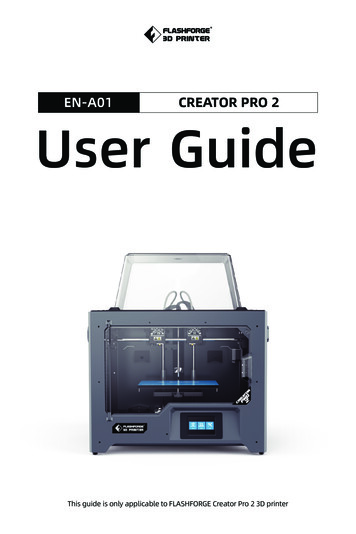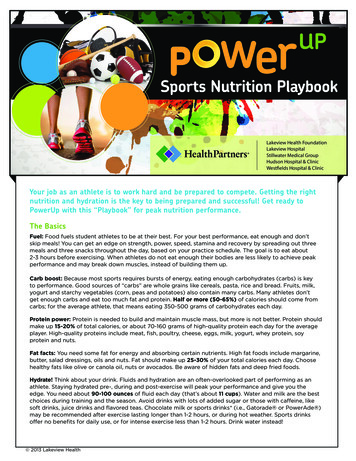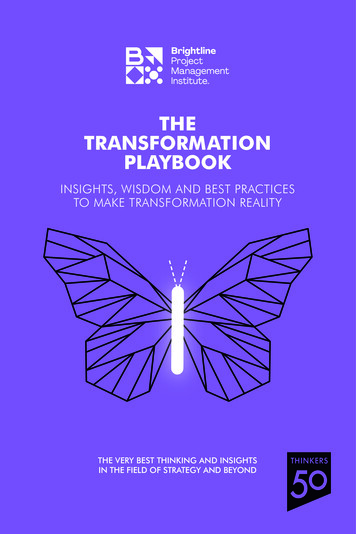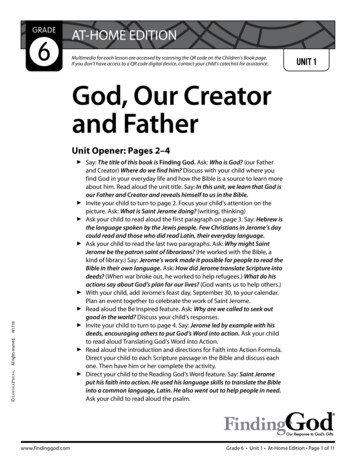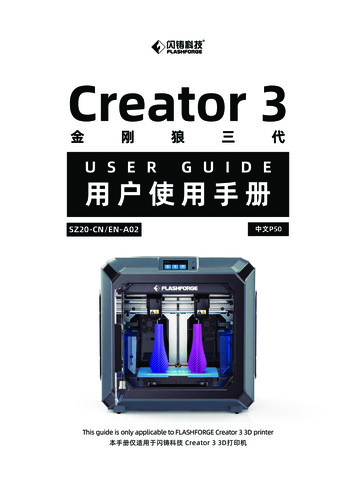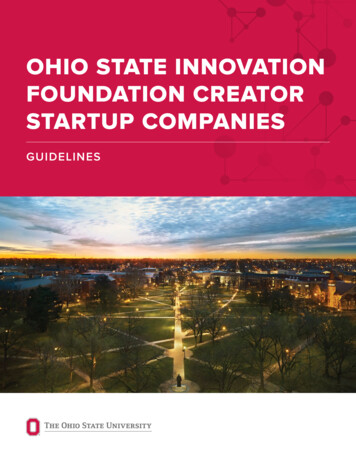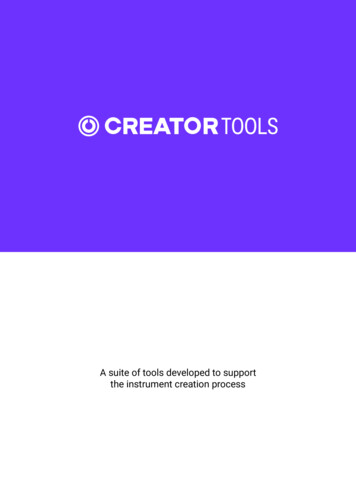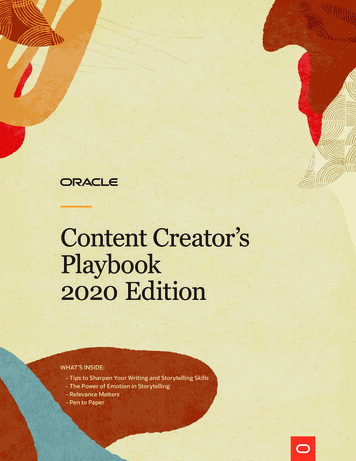
Transcription
Content Creator’sPlaybook2020 EditionWHAT’S INSIDE:- Tips to Sharpen Your Writing and Storytelling Skills- The Power of Emotion in Storytelling- Relevance Matters- Pen to PaperCONTENT CR E ATOR ’ S PL AY B OOK 2020 EDITIONCopyright 20201
Tips to Sharpen Your Writing and Storytelling SkillsContent creation requires writing skills. Good content—whether it’s an email, social media post, guide, case study,or something else—needs good, sharp writing so that is clear and easy to understand and digest. But what is goodwriting? What separates good writing from mediocre or poor? As with any art form, there are not many hard andfast rules to writing, and it can involve much experimentation, and sometimes you can justify breaking whateverconventions do exist. However, there are several rules of thumb every writer needs to bear in mind:1) Clarity is key: Above everything, what you are trying to get across has to be clear. There needs to be a logicalflow from one idea to the next. You have to make sense.2) Show, don’t tell, whenever possible: If you are writing a character, do not tell just your readers that they aremad. Have them be mad! Have them shout, kick something, or punch a wall. If a character is devious, don’t justtell the audience they are. Have them lie, cheat, and steal. The audience needs examples and actions to showthem what is happening and allow them to emphasize with and understand the situation.3) Good writing is concise writing: This does not mean that all writing needs to be short and as cropped aspossible. It means that you should not use any unnecessary words. The piece of content is only as long as itneeds to be, not too short nor too long. It gets to the point, being only the length it needs to do so.4) Whenever possible, use the active and not the passive tense: The active tense means using action verbsin a sentence. In such a sentence, the subject performs an action. The passive tense relies more on being verbsand sentences where in an action is performed upon the subject. The active tense tends to make for stronger,more direct writing and is much easier to read.5) Be specific: Don’t be vague or generic. Be as specific as possible. If someone is listening to music, what isthe song? If you can’t say what the song is, what type of music is it?6) Rewrite and edit: The first draft is always for yourself. You know what you mean, since you’re the one who wrote it.Every other draft is meant for your audience, so you have to make sure someone else can understand it.7) Continue to write and read: Writers write. The only way you become better at anything is to keep at it. Keepwriting, rewriting, and polishing your existing and future projects. And, of course, remember that you also needto read. Language is your tool, and you see at it at work when you read. You can only grow as a writer by bothwriting and reading as much as you can.Those rules of thumb can help you become a good writer, but don’t you want to be a great one? What does take it?Realize first that as a digital marketer you are always telling stories, and what draws people into a story is emotion.Good content—whether it’s an email, social media post, guide, case study, or somethingelse—needs good, sharp writing so that is clear and easy to understand and digest.CONTENT CR E ATOR ’ S PL AY B OOK 2020 EDITIONCopyright 20202
The Power of Emotion in StorytellingContent marketing tells the story of your brand. You’re building yourself up as an authority in your field,someone your customers can turn to when they are in search of solutions. The content marketing funnelitself is a story. A prospect becomes aware of a problem and seeks out a solution.Then they consider and evaluate all the options they have before them beforechoosing one and converting to a customer.GoodWhat drives good storytelling? What captivates your audience and drives them onthrough the content marketing funnel? How can the story you tell captivate them?Of course, everyone loves a good story, and storytelling itself is the best andmore effective means of communication. Using storytelling as your tool, you canestablish your identity, build trust, share information, and influence opinions.But what draws someone into the story? What excites them and causes them todelve deeper and deeper into the story that you crafting toward interest in yourproducts and services?storytellinghits the rightemotionaltriggers, asdoes goodmarketing.Good storytelling hits the right emotional triggers, as does good marketing. The right emotional cues canattach someone to your story—your story—and make them invested in how it turns out. You might evenend up turning a customer their story but with a happy ending due to how you can help them.EMOTION IN B2CB2C marketing relies heavily upon emotion. Many B2C transactions can occur at the spur of the moment,due to what a person is feeling at that time. An updated version of your favorite video game as a youth?A dress that resembles the one you wore to or prom? Your fond memories might make you want to buythings that let you live in nostalgia.You can’t always know what someone’s memories are, however. Still, does having a fine suit likeeveryone else downtown seem enticing? Would it make you feel more accepted? Does your gym offer anew kickboxing workout that will change your world? Does your store use paper bags and not plastic andhas a stance on helping the environment? And, thus, does shopping there mean you’re playing a smallrole in helping the environment?Making someone feel accepted, that they can become a better version of themselves, and contribute to andhelp save the world. These are all powerful emotional triggers that marketers might avail themselves of.CONTENT CR E ATOR ’ S PL AY B OOK 2020 EDITIONCopyright 20203
EMOTION IN B2BSome might claim that emotion factors less into B2B, but that isn’t true. B2B is about building trust andconfidence in your brand. It’s about building a relationship with customers. You are offering solutions to theirproblems and making their jobs—and lives—easier. There’s satisfaction in that, for both you and them. Bothsides should have a sense of achievement at the end of the transaction. Joy and happiness are the two mostpowerful emotions. Solving a problem can lead to both.So, when crafting content, remember that you are always in storytelling mode, and storytelling requires you toalways put yourself in your customer’s shoes. What are they feeling? How can you help? And what emotionscan you trigger? And also, be relevant.Relevance MattersAll day, every day, people are besieged with a multitude of marketing messages.Their email inboxes fill up. They get text after text. Ads show up in any Googlesearch they do and on their social media. You can’t watch TV or listen to the radiowithout dealing with advertisements. It can all become white noise to a person,and it can be difficult to stand out from the rest and capture their attention.Your contentmust engagethe reader.As a marketer, you have to ask yourself what you can do to distinguish yourself.What can you do to pique someone’s interest and hold their attention?To start, don’t assume that you already know it all. You have to continuallyresearch and ask questions to get to the heart of what audiences want. Look atthe data. Speak with an actual customer about their pain points. Pay attention totrends. What is relevant is always changing, and you have to stay on top of things.It has tointerest andintriguethem.Then once you think you have a grasp of what would grab an audience’sattention, you have to put it down and make it communicable. Any piece of writing needs to be clear and easyto understand and digest. Something that is simply well written or better written than the rest can make astrong impression. But you need to go further than that.Your content must engage the reader. It has to interest and intrigue them. And remember that you do nothave a huge amount of space to work with. Many people read emails, texts, conduct business, and more ontheir phones and other mobile devices. You must write and design your content with mobile in mind.This means you understand that you:- Need to be concise and get to the point right away- Must make your content as mobile and reader friendly as possible- Can make the most of the space you have to drive home your pointCONTENT CR E ATOR ’ S PL AY B OOK 2020 EDITIONCopyright 20204
Even if someone is viewing an email or site on the web, you still have onlya brief window of opportunity to interest them. If you fail, your email will bedeleted, or they’ll move onto another site.Obviously, you must optimize your landing pages, emails, texts, and allmarketing materials to offer a pleasing experience with easy navigation andeye-catching designs. But what about your content?How does it stand out? The answer is relevance.Your content should be offering your audience something, a tidbit ofinformation, a how-to tip, or news on products and services that they areinterested in. Your audience is looking for content that helps them solve theirbusiness problems, and you have to deliver it.Your audienceis looking forcontent thathelps themsolve theirbusinessproblems,and you haveHow well do you know your prospects? Do you have an idea of what keepsthem up at night? What are their pain points and what can you do to help?What has your research told you?to deliver it.You need to bear all that in mind when writing your content.Pen to PaperOnce you know the basics, don’t let anything stop you. Put pen to paper and get something done. Justwrite. Don’t worry too much about how good it is for now. Once you have something to work with, youcan go back and change, tweak, and revise it as much as you like. The most important thing is that youget started. Marketing content has to come from somewhere. You might:- Put research, analytics, and data into your work- Have to adhere to your brand’s style guide- Make sure you have the right voice and tone- Have to write with the right audience in mind- Work with an editor and have a second set of eyes look everything over- Take in feedback and revise accordinglyWriting and content creation are artforms. They take time, patience, and skill to master.For more insights into content creation and other vital marketing topics and tools, check outOracle CX Marketing.CONTENT CR E ATOR ’ S PL AY B OOK 2020 EDITIONCopyright 20205
About Oracle Marketing CloudB2B and B2C marketers use Oracle Marketing Cloud, an integrated portfolio of best-in-class applications, to drivesales, brand and customer loyalty. Oracle Marketing Cloud offers the industry’s richest datasets and most adaptiveintelligence so marketers can deliver irresistible, consistent and connected experiences to customers wherever theyare and however they choose to engage.Are you ready to start your real-life mobile marketing marathon? We’ve got just the thing to add to your game.For more marketing insights and thought leadership, please visit .oracle.com/marketingcloud1.800.633.0738Facebook Twitter LinkedIn Blog Oracle Corporation, World Headquarters500 Oracle ParkwayRedwood Shores, CA 94065, USAWorldwide InquiriesPhone: 1.650.506.7000Fax: 1.650.506.7200Intergrated Cloud Applications & Platform ServicesCopyright 2020, Oracle and/or its affiliates. All rights reserved. This document is provided for information purposes only, and the contents hereof are subject to changewithout notice. This document is not warranted to be error-free, nor subject to any other warranties or conditions, whether expressed orally or implied in law, includingimplied warranties and conditions of merchantability or fitness for a particular purpose. We specifically disclaim any liability with respect to this document, and no contractualobligations are formed either directly or indirectly by this document. This document may not be reproduced or transmitted in any form or by any means, electronic ormechanical, for any purpose, without our prior written permission.Oracle and Java are registered trademarks of Oracle and/or its affiliates. Other names may be trademarks of their respective owners.CONTENT CR E ATOR ’ S PL AY B OOK 2020 EDITIONCopyright 20206
Good content—whether it’s an email, social media post, guide, case study, or something else—needs good, sharp writing so that is clear and easy to understand and digest. But what is good writing? What separates good writing from mediocre or poor? As with any art form, there are not many hard and .
